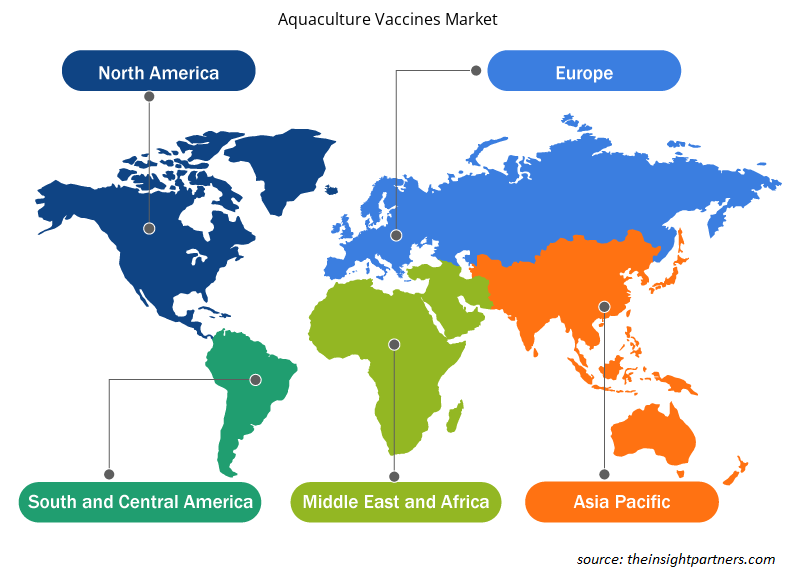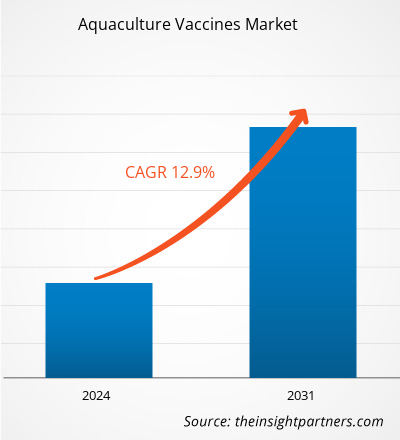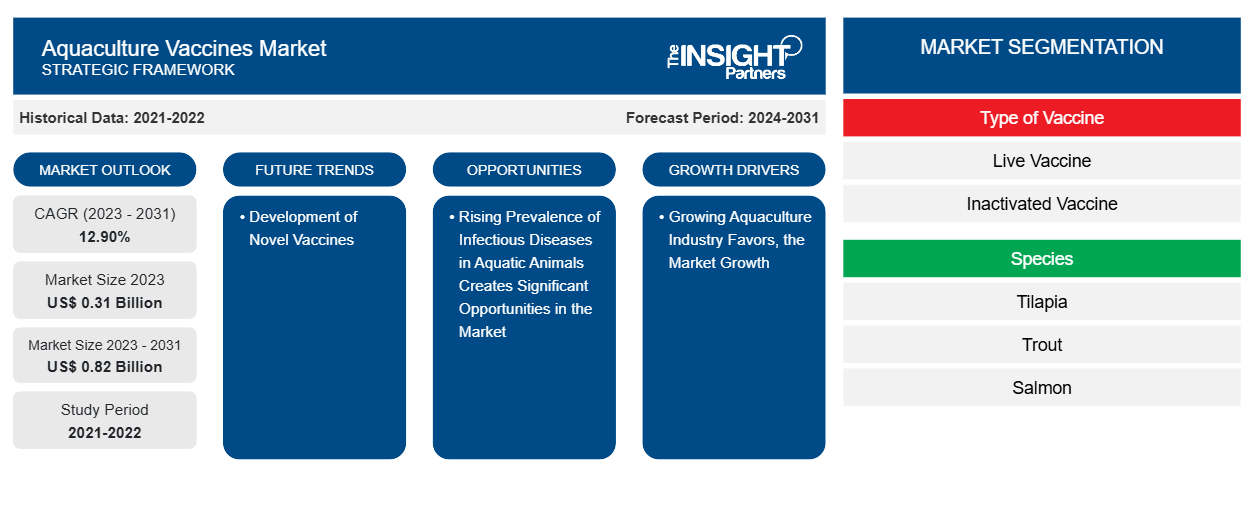Le marché des vaccins pour l'aquaculture devrait atteindre 0,82 milliard USD d'ici 2031, contre 0,31 milliard USD en 2023. Le marché devrait enregistrer un TCAC de 12,90 % au cours de la période 2023-2031. Le développement de nouveaux vaccins restera probablement une tendance clé du marché.CAGR of 12.90% during 2023–2031. The development of novel vaccines will likely remain a key trend in the market.
Analyse du marché des vaccins pour l'aquaculture
Le besoin de vaccins pour traiter les maladies des espèces aquacoles augmentera en raison de la fréquence croissante des maladies infectieuses chez les animaux aquatiques. Le marché sera également soutenu par l'augmentation des initiatives des acteurs du marché, telles que le lancement de nouveaux produits, l'ouverture de nouvelles installations, les investissements dans de nouveaux projets et la collaboration active avec les gouvernements étrangers. La région Asie-Pacifique devrait connaître une croissance significative au cours de la période de prévision en raison des principaux pays producteurs d'aquaculture de la région, de l'essor de l'industrie aquacole et de la demande croissante des consommateurs. Le besoin de vaccins pour l'aquaculture de la région augmentera en raison de ces facteurs.
Aperçu du marché des vaccins pour l'aquaculture
Les agriculteurs ont recours à la vaccination pour l'aquaculture afin d'obtenir une rentabilité élevée en raison de la demande croissante de produits alimentaires dérivés d'animaux aquatiques, tels que l'huile, le caviar, les protéines en poudre et la viande. Le marché connaît également une forte augmentation de la demande de produits carnés de haute qualité, durables et sains, contenant peu ou pas de médicaments. Il est fortement conseillé de consommer fréquemment du poisson dans le cadre d'une alimentation équilibrée. Le poisson peut produire plus de protéines en utilisant son taux d'alimentation plus faible, car il a une teneur en protéines plus élevée que la viande d'animaux terrestres et un indice de conversion alimentaire (IC) plus faible que celui des animaux terrestres.FCR) than land animals.
De plus, les protéines de poisson sont pauvres en acides aminés essentiels et hautement digestibles par rapport aux protéines d'origine animale. Manger du poisson et des crustacés peut réduire le risque d'arthrite, d'inflammation et de maladie cardiaque. Le poisson est considéré comme bénéfique pour la santé principalement parce qu'il contient des acides gras polyinsaturés (AGPI) oméga 3 (n-3) à longue chaîne. De plus, les protéines de poisson contiennent un grand nombre de peptides bioactifs. Si ceux-ci sont pris en bonne quantité et sont biodisponibles pour les humains, ils peuvent avoir de nombreux effets respectables sur la santé. L'inhibition de l'enzyme du système rénine-angiotensine-aldostérone (RAAS) est responsable du contrôle de la pression artérielle. Parmi les autres avantages pour la santé, citons le contrôle de l'inflammation par les peptides antioxydants, le maintien de la santé osseuse, les bienfaits pour la santé mentale des peptides inhibiteurs de l'acétylhydrolase du facteur d'activation des plaquettes (PAF-AH) et des peptides opioïdes, ainsi que plusieurs autres bioactivités. Par conséquent, il existe un besoin croissant de vaccins pour l'aquaculture en raison de la nécessité d'un élevage d'animaux aquatiques sains.
Personnalisez ce rapport en fonction de vos besoins
Vous bénéficierez d'une personnalisation gratuite de n'importe quel rapport, y compris de certaines parties de ce rapport, d'une analyse au niveau des pays, d'un pack de données Excel, ainsi que de superbes offres et réductions pour les start-ups et les universités.
-
Obtenez les principales tendances clés du marché de ce rapport.Cet échantillon GRATUIT comprendra une analyse de données, allant des tendances du marché aux estimations et prévisions.
Facteurs moteurs et opportunités du marché des vaccins pour l'aquaculture
La croissance de l'industrie de l'aquaculture favorise la croissance du marché
L'Organisation des Nations Unies pour l'alimentation et l'agriculture a publié un rapport intitulé « L'état mondial des pêches et de l'aquaculture » en 2022. Le rapport indique que le nombre d'aliments aquatiques consommés dans le monde, à l'exclusion des algues, a été multiplié par plus de cinq par rapport à il y a près de 60 ans. La quantité d'aliments aquatiques consommés dans le monde est passée de 28 millions de tonnes en 1961 à environ 158 millions en 2019. À partir de 1961, le taux de croissance annuel moyen de la consommation était de 3,0 %, tandis que le taux de croissance démographique était de 1,6 %. L'augmentation des revenus, l'évolution des préférences des consommateurs et l'expansion de l'offre contribuent à une augmentation de la consommation par habitant. La consommation d'aliments aquatiques par habitant dans 227 pays a été projetée par l'Organisation des Nations Unies pour l'alimentation et l'agriculture en 2019. En termes de population, en 2019, les pays ayant une consommation mondiale moyenne plus faible représentaient 54 % de la population mondiale. Avec plus de 80 kg d’aliments aquatiques consommés par an et par personne, l’Islande, les îles Féroé et les Maldives sont les pays qui consomment le plus d’aliments aquatiques. En 2019, la consommation moyenne mondiale par habitant était de 20,5 kg. En revanche, le poids moyen dans les pays à revenu élevé était de 26,5 kg, tandis que dans les pays à faible revenu, il était de 5,4 kg.
L'industrie de l'aquaculture se développe plus rapidement que prévu en raison de la demande croissante d'animaux. Les vaccins destinés à l'aquaculture réduisent le risque d'infection et augmentent le rendement des produits. En conséquence, le marché des vaccins pour l'aquaculture est en pleine croissance en raison de l'expansion du secteur de l'aquaculture.
La prévalence croissante des maladies infectieuses chez les animaux aquatiques crée des opportunités importantes sur le marché
Français Selon l'étude de recherche de la Bibliothèque nationale de médecine (NLM) « Prévalence des nématodes anisakidés dans les poissons en Chine : examen systématique et méta-analyse », publiée en février 2022, les nématodes anisakidés étaient courants chez les poissons dans toute la Chine, avec un taux d'incidence groupé de 45,5 %. Le pourcentage d'occurrence le plus élevé a été trouvé dans le poisson frais (58,1 %). Les nématodes anisakidés étaient les plus répandus dans l'est de la Chine (55,3 %), la mer de Chine orientale ayant la prévalence la plus élevée (76,8 %). Les données de la revue Aquaculture Research & Development indiquent qu'entre 2014 et 2018, environ 219 cas de maladies infectieuses ont été signalés dans l'industrie de l'aquaculture fraîche. Parmi ceux-ci, 1,83 % étaient viraux, 74,88 % étaient parasitaires, 12,80 % étaient bactériens et 10,50 % des cas combinaient des maladies bactériennes et parasitaires. Par conséquent, il est prévu que la forte incidence des maladies infectieuses augmentera la demande de vaccins, ouvrant ainsi des opportunités rentables pour le marché des vaccins pour l’aquaculture à l’avenir.NLM) research study "Prevalence of Anisakid Nematodes in Fish in China: A Systematic Review and Meta-Analysis," which was released in February 2022, anisakid nematodes were common in fish throughout China, with a pooled incidence rate of 45.5%. The highest occurrence percentage was found in fresh fish (58.1%). Anisakid nematodes were most prevalent in Eastern China (55.3%), with the East China Sea having the highest prevalence (76.8%). Data from the Aquaculture Research & Development journal indicates that from 2014 to 2018, approximately 219 cases of infectious diseases were reported in the fresh aquaculture industry. Of these, 1.83% were viral, 74.88% were parasitic, 12.80% were bacterial, and 10.50% of cases combined bacterial and parasitic illnesses. Consequently, it is anticipated that the high incidence of infectious diseases will increase demand for vaccinations, opening up profitable opportunities for the aquaculture vaccines market in the future.
Analyse de segmentation du rapport sur le marché des vaccins pour l'aquaculture
Les segments clés qui ont contribué à l’élaboration de l’analyse du marché des vaccins pour l’aquaculture sont le type de vaccin, l’espèce et la voie d’administration.
- En fonction du type de vaccin, le marché des vaccins pour l'aquaculture est segmenté en vaccins vivants, vaccins inactivés et autres. Le segment des vaccins inactivés détenait la part de marché la plus importante en 2023.
- Par espèce, le marché est catégorisé en tilapia, truite, saumon, crevettes et autres. Le segment de la truite détenait la plus grande part du marché en 2023.
- En fonction du mode d'administration, le marché est segmenté en vaccins injectables, vaccins par immersion et vaccins oraux. Le segment des vaccins injectables détenait la part de marché la plus importante en 2023.
Analyse des parts de marché des vaccins pour l'aquaculture par zone géographique
La portée géographique du rapport sur le marché des vaccins pour l’aquaculture est principalement divisée en cinq régions : Amérique du Nord, Asie-Pacifique, Europe, Moyen-Orient et Afrique, et Amérique du Sud et centrale.
Les États-Unis, le Canada et le Mexique constituent les trois segments du marché nord-américain des vaccins pour l'aquaculture. Les États-Unis détiennent la plus grande part du marché des vaccins pour l'aquaculture en Amérique du Nord. Les principaux moteurs de la croissance du marché sont la forte incidence des maladies infectieuses dans l'industrie de l'aquaculture, l'augmentation des niveaux de production et le développement et l'introduction croissants de nouveaux vaccins pour l'aquaculture. Les États-Unis ont produit 5,2 millions de tonnes de poisson en 2018, d'une valeur de 7 063,5 millions de dollars américains, selon l'Étude de l'OCDE sur les pêcheries 2020. 17 % provenaient de l'aquaculture et 83 % de la pêche. Alors que sa valeur a augmenté de 29 %, la quantité de production a augmenté de 7 % entre 2008 et 2018.
En outre, les acteurs du marché ont accéléré la production de produits technologiquement développés dans le pays. Par exemple, en septembre 2020, Virbac a acquis une gamme de vaccins pour tilapia auprès d'Ictyogroup, une société de santé animale spécialisée dans la biologie R&D. Le groupe Virbac a reçu les droits de distribution et de commercialisation de vaccins homologués et autogènes dans le monde entier. En plus de l'acquisition, comme mentionné précédemment, les deux sociétés se sont associées pour le développement par Ictyogroup de nouvelles formulations et de nouveaux vaccins, toujours pour la division Aqua Virbac, le tilapia et les entreprises du marché de l'aquaculture. L'accord prévoit également le transfert d'Ictyogroup à Virbac de plusieurs employés spécialisés dans le support technique marketing et la biologie R&D. Ainsi, les développements croissants des différents acteurs du marché de l'aquaculture américaine et les facteurs ci-dessus stimuleront le marché des vaccins pour l'aquaculture aux États-Unis.
Aperçu régional du marché des vaccins pour l'aquaculture
Les tendances et facteurs régionaux influençant le marché des vaccins pour l’aquaculture tout au long de la période de prévision ont été expliqués en détail par les analystes d’Insight Partners. Cette section traite également des segments et de la géographie du marché des vaccins pour l’aquaculture en Amérique du Nord, en Europe, en Asie-Pacifique, au Moyen-Orient et en Afrique, ainsi qu’en Amérique du Sud et en Amérique centrale.

- Obtenez les données régionales spécifiques au marché des vaccins pour l'aquaculture
Portée du rapport sur le marché des vaccins pour l'aquaculture
| Attribut de rapport | Détails |
|---|---|
| Taille du marché en 2023 | 0,31 milliard de dollars américains |
| Taille du marché d'ici 2031 | 0,82 milliard de dollars américains |
| Taux de croissance annuel composé mondial (2023-2031) | 12,90% |
| Données historiques | 2021-2022 |
| Période de prévision | 2024-2031 |
| Segments couverts |
Par type de vaccin
|
| Régions et pays couverts |
Amérique du Nord
|
| Leaders du marché et profils d'entreprises clés |
|
Densité des acteurs du marché des vaccins pour l'aquaculture : comprendre son impact sur la dynamique commerciale
Le marché des vaccins pour l'aquaculture connaît une croissance rapide, tirée par la demande croissante des utilisateurs finaux en raison de facteurs tels que l'évolution des préférences des consommateurs, les avancées technologiques et une plus grande sensibilisation aux avantages du produit. À mesure que la demande augmente, les entreprises élargissent leurs offres, innovent pour répondre aux besoins des consommateurs et capitalisent sur les tendances émergentes, ce qui alimente davantage la croissance du marché.
La densité des acteurs du marché fait référence à la répartition des entreprises ou des sociétés opérant sur un marché ou un secteur particulier. Elle indique le nombre de concurrents (acteurs du marché) présents sur un marché donné par rapport à sa taille ou à sa valeur marchande totale.
Les principales entreprises opérant sur le marché des vaccins pour l'aquaculture sont :
- Tactiques Aquatiques Santé des Poissons
- HIPRA SA
- Merck & Co Inc.
- Microsynbiotix Ltée
- Société indienne d'immunologie Ltée
- Nisseiken Co Ltd
Avis de non-responsabilité : les sociétés répertoriées ci-dessus ne sont pas classées dans un ordre particulier.

- Obtenez un aperçu des principaux acteurs du marché des vaccins pour l'aquaculture
Actualités et développements récents du marché des vaccins pour l'aquaculture
Le marché des vaccins pour l'aquaculture est évalué en collectant des données qualitatives et quantitatives après des recherches primaires et secondaires, qui comprennent d'importantes publications d'entreprise, des données d'association et des bases de données. Quelques-uns des développements sur le marché des vaccins pour l'aquaculture sont énumérés ci-dessous :
- Merck Animal Health, connue sous le nom de MSD Animal Health en dehors des États-Unis et du Canada, une division de Merck & Co., Inc., a annoncé avoir signé un accord définitif pour acquérir l'activité aquacole d'Elanco Animal Health Incorporated pour 1,3 milliard de dollars US en espèces, composée d'un portefeuille innovant de médicaments et de vaccins, de nutrition et de suppléments pour les espèces aquatiques ; deux installations de fabrication aquacoles connexes au Canada et au Vietnam ; ainsi qu'un centre de recherche au Chili. L'acquisition devrait être finalisée d'ici le milieu de l'année 2024, sous réserve des approbations des autorités réglementaires et d'autres conditions de clôture habituelles. (Source : Merck Animal Health, communiqué de presse, février 2024)
Rapport sur le marché des vaccins pour l'aquaculture : couverture et livrables
Le rapport « Taille et prévisions du marché des vaccins pour l’aquaculture (2021-2031) » fournit une analyse détaillée du marché couvrant les domaines ci-dessous :
- Taille et prévisions du marché des vaccins pour l'aquaculture aux niveaux mondial, régional et national pour tous les segments de marché clés couverts par le champ d'application
- Tendances du marché des vaccins pour l'aquaculture ainsi que la dynamique du marché, comme les facteurs moteurs, les contraintes et les opportunités clés
- Analyse détaillée des cinq forces de PEST/Porter et SWOT
- Analyse du marché des vaccins pour l'aquaculture couvrant les principales tendances du marché, le cadre mondial et régional, les principaux acteurs, les réglementations et les développements récents du marché.
- Analyse du paysage industriel et de la concurrence couvrant la concentration du marché, l'analyse de la carte thermique, les principaux acteurs et les développements récents du marché des vaccins pour l'aquaculture
- Profils d'entreprise détaillés
- Analyse historique (2 ans), année de base, prévision (7 ans) avec TCAC
- Analyse PEST et SWOT
- Taille du marché Valeur / Volume - Mondial, Régional, Pays
- Industrie et paysage concurrentiel
- Ensemble de données Excel
Rapports récents
Témoignages
Raison d'acheter
- Prise de décision éclairée
- Compréhension de la dynamique du marché
- Analyse concurrentielle
- Connaissances clients
- Prévisions de marché
- Atténuation des risques
- Planification stratégique
- Justification des investissements
- Identification des marchés émergents
- Amélioration des stratégies marketing
- Amélioration de l'efficacité opérationnelle
- Alignement sur les tendances réglementaires























 Obtenez un échantillon gratuit pour - Marché des vaccins pour l'aquaculture
Obtenez un échantillon gratuit pour - Marché des vaccins pour l'aquaculture